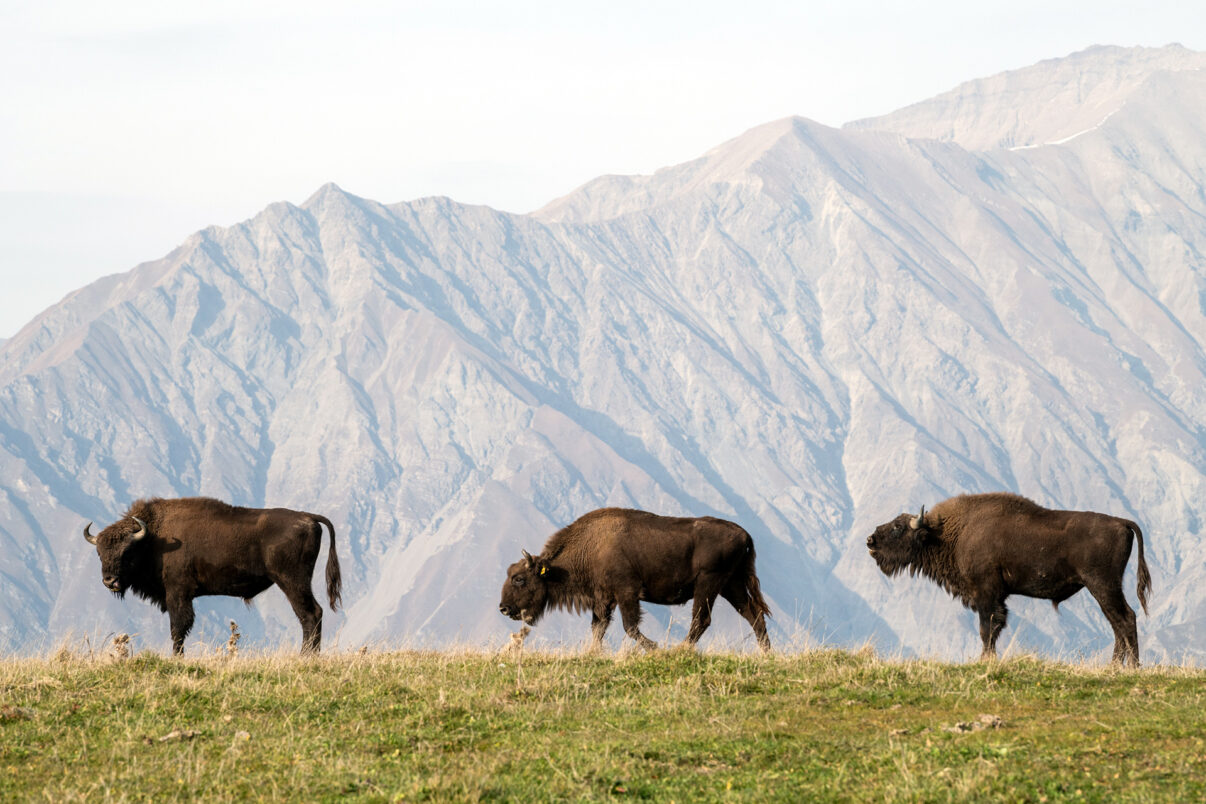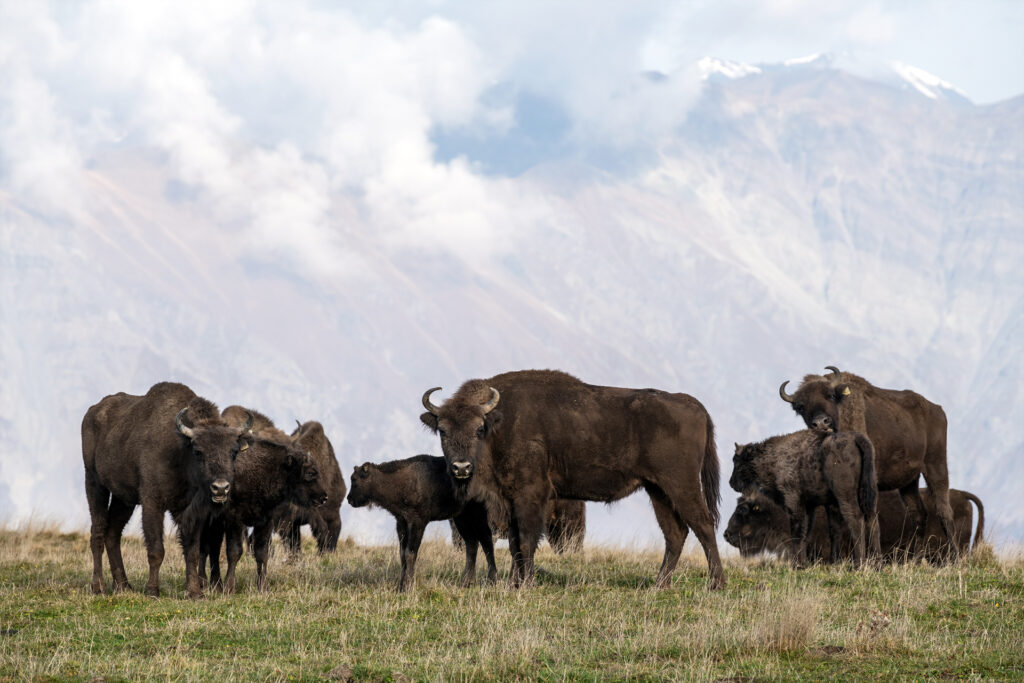An ambitious initiative to establish a viable, self-sustaining, free-ranging population of European bison in Azerbaijan has taken a step forward with the support of Rewilding Europe’s European Wildlife Comeback Fund.

Pioneering reintroduction
A 41,800-euro grant from Rewilding Europe’s Wildlife Comeback Fund has just supported the translocation of 10 European bison – two males and eight females – from Tierpark Berlin to Shahdag National Park in northern Azerbaijan. They join a herd of free-roaming bison previously released in the 130,000-hectare protected area, in a move that supports the ongoing recovery of the species in the Caucasus region and beyond.
An international European bison reintroduction programme began in Shahdag National Park in 2019. Within this, Zoo and Tierpark Berlin and WWF Germany have been collaborating to translocate 10 European bison to the park every year, as part of the European bison breeding programme of the European Association of Zoos and Aquaria (EAZA).
Before the latest transport, 36 bison had been released in the park’s core zone. These bison, which were also sourced from European zoos, have acclimatised well and have already reproduced, with 18 calves born to date, including 10 in 2023. Including the new arrivals, the population in Shahdag National Park now stands at 58 individuals. The bison involved in the latest translocation were also sourced from various zoos across Europe and allowed to form a herd at Tierpark Berlin before their move, giving them the best chance of thriving in the wild.
Critical funding
Shahdag National Park encompasses a variety of ecosystems, mainly montane forests and alpine meadows. It was selected as a site for European bison reintroduction because of these habitats, its status as a protected area, and the availability of WWF field staff to monitor and protect the animals.
The bison that have just been translocated will initially be kept in a two-hectare acclimatisation enclosure, and then transferred to a 300-hectare soft release enclosure. The animals will eventually be released to roam free in the park’s core zone in the spring next year, where they are expected to have a positive impact on biodiversity through their interaction with the landscape. For example, when roaming through thick vegetation, the bison create pathways which enable shorter plants access to additional sunlight, and other wildlife species easier passage through the landscape.
The grant from the European Wildlife Comeback Fund was used to pay for transportation, foraging materials, fencing, local veterinary services, GPS collars and monitoring, and educational outreach. Farmers around the park benefit financially from the translocation by providing hay and acorns that are use during the release process, and it is expected that the park’s increasing bison population will prove a growing tourism attraction, with associated economic benefits for local communities.

Network support
Complementing the funding provided by the European Wildlife Comeback Fund, the “Reintroduction of European bison to Shahdag National Park” initiative will also benefit from membership of Rewilding Europe’s European Rewilding Network. The initiative has just become the network’s 91st member, with membership now spanning 29 European countries. With other European Rewilding Network members involved in the reintroduction of European bison, this will strengthen the network’s collective expertise and enhance ongoing efforts to reintroduce the species in Azerbaijan and beyond.
Back from the brink
The European bison, Europe’s largest native land mammal, was historically distributed throughout western, central and southeastern Europe, extending to Russia’s Volga River and down to the Caucasus region. With the shooting of the last wild bison in the Caucasus in 1927, the species was completely wiped out in its natural habitat.
It is from this low point that the European bison has slowly but surely inched its way back, supported by various breeding programmes and reintroduction. Zoos and breeding centres such as Zoo and Tierpark Berlin will continue to play a key role in this process, with many participating in the European bison breeding programme of the European Association of Zoos and Aquaria (EAZA).
There are now a wide range of European bison reintroduction initiatives taking place across Europe – including in Rewilding Europe’s Southern Carpathians (Romania) and Rhodope Mountains (Bulgaria) rewilding landscapes. Over the last decade, the estimated number of free-roaming European bison has increased from 2579 to more than 7000 individuals, with the largest herds found in Belarus and Poland.

Closing the gap
There were 16 subpopulations of European bison in Russia in 2020, totalling more than 1300 animals, with a number of herds based in the Caucasus region. However, there is no natural exchange among these herds, which is a challenge considering the limited genetic diversity of the species – a result of its near extinction. The Caucasus contains some of the last remaining wilderness areas in Europe where apex predators and large wild herbivores still exist in large enough numbers to shape natural processes, making it a prime candidate site for further European bison reintroductions.
“Currently, the European bison population in Shahdag National Park is the only European bison population in Azerbaijan,” explains Katharina Hermann, Wildlife Conservation Coordinator at Zoo and Tierpark Berlin. “The overall aim of the reintroduction initiative is to establish a free-ranging founder population of at least 100 animals, which will then have the potential to grow without further support. From a regional and European perspective, we are aiming to close the gap for the species in the Caucasus area – patching the different pieces in the population and closing the gap genetically and demographically.”

Let’s rewild together
The European Wildlife Comeback Fund, which aims to scale up keystone species reintroduction and population reinforcement across Europe, is designed to support wildlife comeback in a convenient and flexible way. Rewilding Europe invites other initiatives working to reintroduce keystone species in European landscapes to consider applying for a grant from the fund.
Those interested in contributing to wildlife recovery in Europe can support wildlife comeback with an online donation. If you’d like to invest more than 50,000 euros in the European Wildlife Comeback Fund, we’d love to speak with you personally.
Rewilding Europe also extends a warm welcome to all European rewilding initiatives that focus on practical, result-oriented rewilding and encourages them to apply for European Rewilding Network membership.
The reintroduction of bison in Shahdag National Park is also supported by Azerbaijani NGO the IDEA Association, Azerbaijan’s Ministry of Ecology and Natural Resources, and WWF Azerbaijan.
